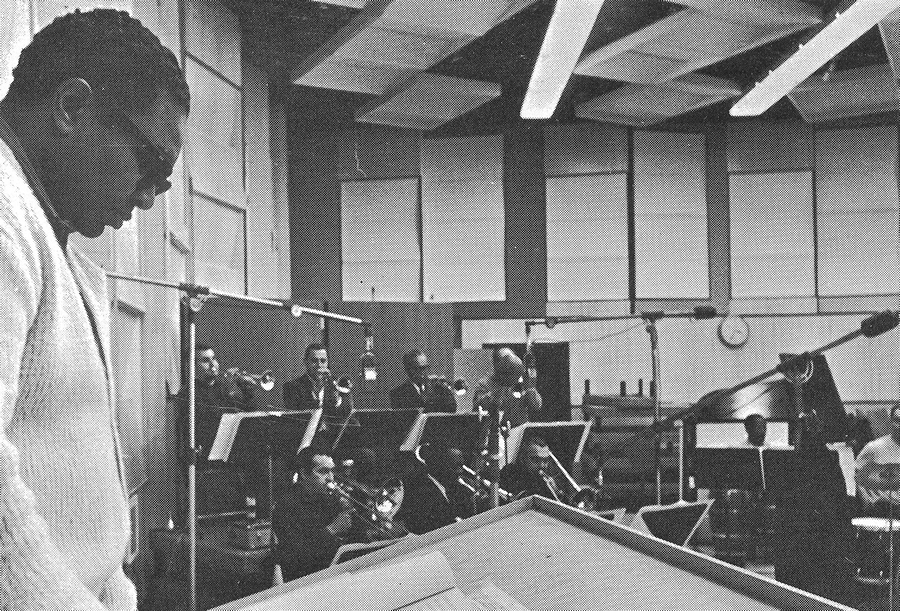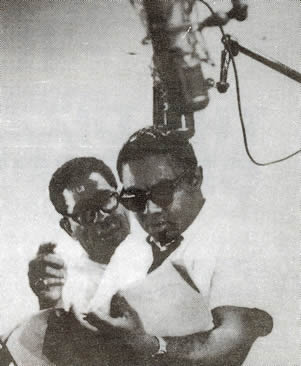


""...A composer can be typecast based on one aspect of their work, just as surely as an actor can wind up getting offered nothing but villain roles. A good example is Gil Fuller, whose real name was Walter Fuller but should not be confused with the older jazz trumpeter and vocalist with the same name. Fuller was identified as a bebop man thanks to a wildly successful relationship with trumpeter, bandleader and sometimes vocalist Dizzy Gillespie that included trademark recordings, including the exciting "Manteca" , "Tin Tin Deo" and "One Bass Hit".
The career that eventually led to film music, collaborating with Ray Charles and the establishment of something along the lines of a stock arrangement factory began in the years prior to the second World War. Bandleaders such as Les Hite, Jimmie Lunceford and Tiny Bradshaw were the first that seemed as if they couldn't get their fill of Fuller. The situation continued improving for him after the war when he was literally writing for all the major big bands at one time out of a New York City home base. Tadd Dameron, Gil Evans and George Russell were the other major jazz figures with whom he shared the distinction of being the first to compose big band charts in the bebop style.
Eventually Fuller established his own publishing company, a natural outlet when he branched out into writing texts about his music, including an analytical discussion of his arrangement methods. Under his own name he created an album entitled The Scene Changes and by actually incorporating his own name he composed a whimsical portrait of his brush with fame, "Fuller Bop Man". In the '60s he was once again associated with modernistic jazz, this time going back to writing for Stan Kenton, with whom he had first worked in 1955. One of Kenton's more interesting projects in this later period was the so-called "neophonic band" in which Fuller's old chum Gillespie appeared as soloist.
--- by Eugene Chadbourne (edited) ALL MUSIC GUIDE
• Gil Fuller and his Orchestra (Vogue, 1949)
• Gilberto - Cha Cha Cha (Mercury, 1957)
• Gil Fuller and the Monterey Jazz Festival Orchestra featuring Dizzy Gillespie (Pacific Jazz, 1965)
• Night Flight featuring James Moody (Pacific Jazz, 1965)
Track listing
All compositions by Gil Fuller except as indicated
1 "Tin Tin Deo" (Gil Fuller, Chano Pozo) - 2:53
2 "I'm in the Mood for Love" (Dorothy Fields, Jimmy McHugh) - 3:36
3 "Night Flight" (Johnny Mangus) - 3:02
4 "Our Man Flint" (Jerry Goldsmith) - 3:01
5 "Seesaw" - 3:36
6 "Batucada Surgiu" (Marcos Valle, Paulo Sergio Valle) - 2:25
7 "17 Mile Drive" - 4:11
8 "A Patch of Blue" (Goldsmith) - 2:41
9 "Latin Lady" - 5:36
10 "Blues for a Debutante" - 2:34
11 "Sweets for My Sweet" (Doc Pomus, Mort Shuman) - 2:50
12 "Wild Chestnuts" (Bill Hood) - 2:20
Track listing
All compositions by Gil Fuller except as indicated
1 "Man from Monterey" (Phil Moore III) - 4:00
2 "Angel City" - 8:20
3 "Love Theme from the Sandpiper" (Johnny Mandel, Paul Francis Webster) - 2:48
4 "Groovin' High" (Dizzy Gillespie) - 3:27
5 "Be's That Way" - 4:39
6 "Big Sur" - 4:37
7 "Moontide" - 3:56
8 "Things Are Here" (Gillespie) - 4:19
Track listing
All compositions by Gil Fuller aka “Gilberto” and "Mario Turner" except as indicated
1 “Campesino” (Mario Turner - aka Gilberto (Gil Fuller)
2 “Mangos” (Mario Turner - aka Gilberto (Gil Fuller)
3 “Suave Cha Cha Cha” (Mario Turner - aka Gilberto (Gil Fuller)
4 “Mudable - Facil-Para Bilar” High" (Mario Turner - aka Gilberto (Gil Fuller)
5 “Jannat” (Mario Turner - aka Gilberto (Gil Fuller)
6 “Molique” (Mario Turner - aka Gilberto (Gil Fuller)
7 "Mantequilla” (Mario Turner - aka Gilberto (Gil Fuller)
8 “Cha Cha Cha Carnival” ((Mario Turner - aka Gilberto (Gil Fuller)
9 “Cha Cha Cha En Boogie” ((Mario Turner - aka Gilberto (Gil Fuller)
10 “Chevere” ((Mario Turner - aka Gilberto (Gil Fuller)
11 “Alo Ultimo” ((Mario Turner - aka Gilberto (Gil Fuller)
This album was created under BMI music publishing under aka “GILBERTO” for “GIL FULLER”.
This is a latin music with a message; as arranged composed and presented by GILBERTO (aka Mario Turner/ Gil Fuller) - a phenomenon in modern Latin and American rhythms and melodies. He began his career as an electrical engineer (Graduated from Newark College of Engineering; now known as New Jersey Institute of Technology (NJIT)) and studied music as a hobby (as a young child and young adult) and attended Julliard School of Music later on; yet unintentionally became a success as an arranger and composer (for Dorsey Brothers, Les Hite, Jimmie Lunceford and Tiny Bradshaw to name a few). His “TROPICANA, “MANTECA” (written by Chano Pozo, Dizzy Gillespie and Gil Fuller) “TIN TIN DEO (written by Chano Pozo & Gil Fuller) have been recorded, played and acclaimed all over the world by “MACHITO”, “TITO PUENTE”, “DIZZY GILLESPIE”, “STAN KENTON” “CANNONBALL ADDERLY”, “RED GARLAND”, “DAVE SANBORN” and others.
Although GILBERTO (aka for Gil Fuller) has been a major factor in the revolution of modern Latin and American music, most of his roles have been behind the scenes as an arranger+composer and organizer of many famous orchestras (i.e. “RAY CHARLES” “MODERN SOUNDS in COUNTRY and WESTERN MUSIC”, etc.) radio (“JOHNNY MAGNUS RADIO SHOW- WEATHER WITH A BEAT” “NIGHT FLIGHT” etc.) and television shows.

Gil Fuller with Dizzy Gillespie 1963
Walter Gilbert "Gil" Fuller (April 14, 1920 – May 26, 1994) was an American jazz composer and arranger.
In the 1930s and 1940s, Fuller did extensive work writing and arranging for bandleaders such as Les Hite, Jimmy Lunceford, Billy Ecstine, Tommy Dorsey and Tiny Bradshaw and also worked with greats such as Benny Carter, Woody Herman, Count Basie, Machito, Chano Pozo, Stan Kenton, and Tito Puente. He was a Lieutenant Colonel in the US Army Air Force (Tuskegee Airman) and flew the well known P-51 fighter plane in the European theatre.
After World War II he found himself in demand as a bebop arranger along with Gil Evans and George Russell. Fuller created most of Dizzy Gillespie’s arrangements at that time and started his own publishing company in 1957 and while he continued to work with some jazz musicians (including Stan Kenton Stan Kenton in 1955 and again in the 1960s at the Dorothy Chandler Music Pavilion in Los Angeles), he also branched out into film music and pop (with Ray Charles, (Modern Sounds in Country and Western Music Album, among others).
© 2015 GIL FULLER WEBSITE Development | Up to Menu